Case Study: Delta Line Motion System Solutions for Robotics
Using technological innovation for environmental benefits
Making life friendlier with personal robots
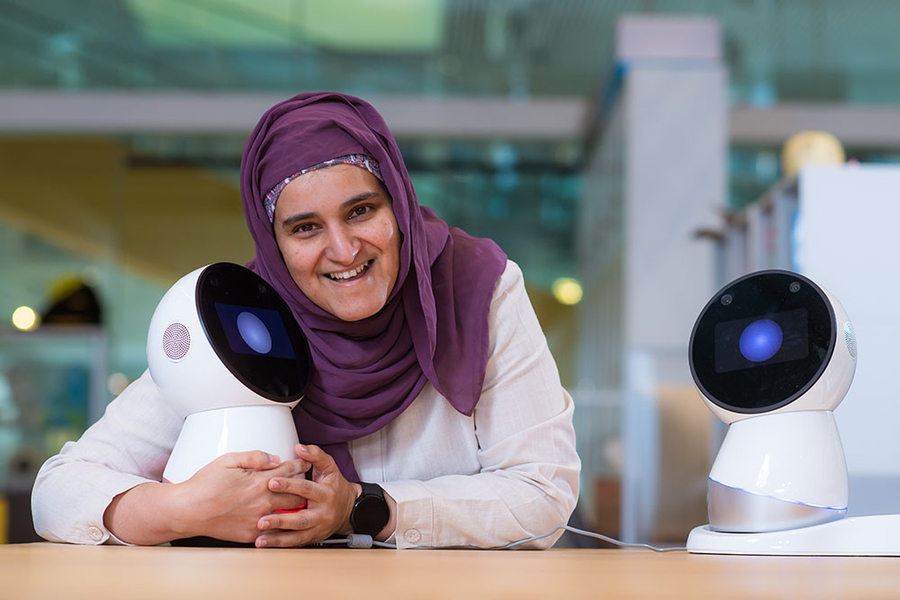
Sharifa Alghowinem, a research scientist in the Media Lab’s Personal Robots Group, poses with Jibo, a friendly robot companion developed by Professor Cynthia Breazeal. Credits: Gretchen Ertl
By Dorothy Hanna | Department of Mechanical Engineering
“As a child, I wished for a robot that would explain others’ emotions to me” says Sharifa Alghowinem, a research scientist in the Media Lab’s Personal Robots Group (PRG). Growing up in Saudi Arabia, Alghowinem says she dreamed of coming to MIT one day to develop Arabic-based technologies, and of creating a robot that could help herself and others navigate a complex world.
In her early life, Alghowinem faced difficulties with understanding social cues and never scored well on standardized tests, but her dreams carried her through. She earned an undergraduate degree in computing before leaving home to pursue graduate education in Australia. At the Australian National University, she discovered affective computing for the first time and began working to help AI detect human emotions and moods, but it wasn’t until she came to MIT as a postdoc with the Ibn Khaldun Fellowship for Saudi Arabian Women, which is housed in the MIT Department of Mechanical Engineering, that she was finally able to work on a technology with the potential to explain others’ emotions in English and Arabic. Today, she says her work is so fun that she calls the lab “my playground.”
Alghowinem can’t say no to an exciting project. She found one with great potential to make robots more helpful to people by working with Jibo, a friendly robot companion developed by the founder of the Personal Robots Group (PRG) and the social robot startup Jibo Inc., MIT Professor and Dean for Digital Learning Cynthia Breazeal. Breazeal’s research explores the potential for companion robots to go far beyond assistants who obey transactional commands, like requests for the daily weather, adding items to shopping lists, or controlling lighting. At the MIT Media Lab, the PRG team designs Jibo to make him an insightful coach and companion to advance social robotics technologies and research. Visitors to the MIT Museum can experience Jibo’s charming personality.
Alghowinem’s research has focused on mental health care and education, often working with other graduate students and Undergraduate Research Opportunity Program students in the group. In one study, Jibo coached young and older adults via positive psychology. He adapted his interventions based on the verbal and non-verbal responses he observed in the participants. For example, Jibo takes in the verbal content of a participant’s speech and combines it with non-verbal information like prolonged pauses and self-hugs. If he concludes that deep emotions have been disclosed, Jibo responds with empathy. When the participant doesn’t disclose, Jibo asks a gentle follow up question like, “Can you tell me more?”
Another project studied how a robot can effectively support high-quality parent and child interactions while reading a storybook together. Multiple PRG studies work together to learn what types of data are needed for a robot to understand people’s social and emotional states.
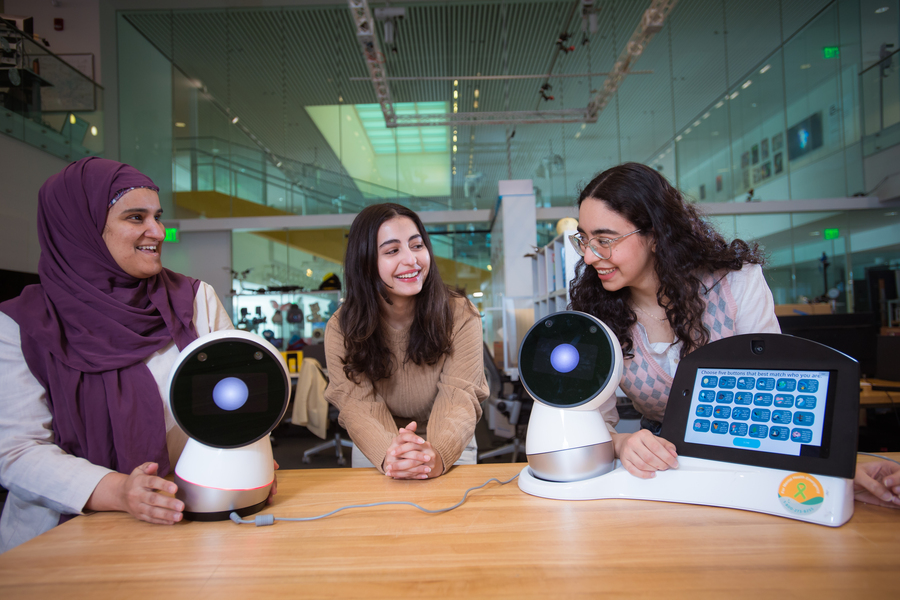
Research Scientist Sharifa Alghowinem (left) and visiting students Deim Alfozan and Tasneem Burghleh from Saudi Arabia’s Prince Sultan University, interact with Jibo. Credits: Gretchen Ertl
“I would like to see Jibo become a companion for the whole household,” says Alghowinem. Jibo can take on different roles with different family members such as a companion, reminding elders to take medication, or as a playmate for children. Alghowinem is especially motivated by the unique role Jibo could play in emotional wellness, and playing a preventative role in depression or even suicide. Integrating Jibo into daily life provides the opportunity for Jibo to detect emerging concerns and intervene, acting as a confidential resource or mental health coach.
Alghowinem is also passionate about teaching and mentoring others, and not only via robots. She makes sure to meet individually with the students she mentors every week and she was instrumental earlier this year in bringing two visiting undergraduate students from Prince Sultan University in Saudi Arabia. Mindful of their social-emotional experience, she worked hard to create the opportunity for the two students, together, to visit MIT so they could support each other. One of the visiting students, Tasneem Burghleh, says she was curious to meet the person who went out of her way to make opportunities for strangers and discovered in her an “endless passion that makes her want to pass it on and share it with everyone else.”
Next, Alghowinem is working to create opportunities for children who are refugees from Syria. Still in the fundraising stage, the plan is to equip social robots to teach the children English language and social-emotional skills and provide activities to preserve cultural heritage and Arabic abilities.
“We’ve laid the groundwork by making sure Jibo can speak Arabic as well as several other languages,” says Alghowinem. “Now I hope we can learn how to make Jibo really useful to kids like me who need some support as they learn how to interact with the world around them.”
Robot fried chicken: entrepreneur seeks to improve S. Korea’s favorite food
Fiber-infused ink enables 3D-printed heart muscle to beat
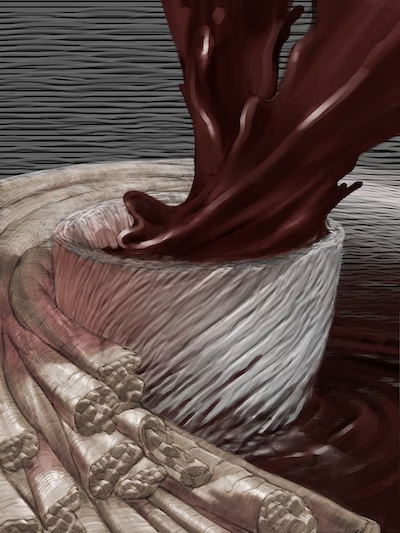
This illustration shows a 3D printed heart ventricle engineered with fiber-infused ink. Credit: Harvard SEAS
By Kat J. McAlpine / SEAS Communications
Over the last decade, advances in 3D printing have unlocked new possibilities for bioengineers to build heart tissues and structures. Their goals include creating better in vitro platforms for discovering new therapeutics for heart disease, the leading cause of death in the United States, responsible for about one in every five deaths nationally, and using 3D-printed cardiac tissues to evaluate which treatments might work best in individual patients. A more distant aim is to fabricate implantable tissues that can heal or replace faulty or diseased structures inside a patient’s heart.
In a paper published in Nature Materials, researchers from Harvard John A. Paulson School of Engineering and Applied Sciences (SEAS) and the Wyss Institute for Biologically Inspired Engineering at Harvard University report the development of a new hydrogel ink infused with gelatin fibers that enables 3D printing of a functional heart ventricle that mimics beating like a human heart. They discovered the fiber-infused gel (FIG) ink allows heart muscle cells printed in the shape of a ventricle to align and beat in coordination like a human heart chamber.
“People have been trying to replicate organ structures and functions to test drug safety and efficacy as a way of predicting what might happen in the clinical setting,” says Suji Choi, research associate at SEAS and first author on the paper. But until now, 3D printing techniques alone have not been able to achieve physiologically-relevant alignment of cardiomyocytes, the cells responsible for transmitting electrical signals in a coordinated fashion to contract heart muscle.
“We started this project to address some of the inadequacies in 3D printing of biological tissues.”
– Kevin “Kit” Parker
The innovation lies in the addition of fibers within a printable ink. “FIG ink is capable of flowing through the printing nozzle but, once the structure is printed, it maintains its 3D shape,” says Choi. “Because of those properties, I found it’s possible to print a ventricle-like structure and other complex 3D shapes without using extra support materials or scaffolds.”
This video shows the spontaneous beating of a 3D-printed heart muscle. Credit: Harvard SEAS.
To create the FIG ink, Choi leveraged a rotary jet spinning technique developed in the lab of Kevin “Kit” Parker, Ph.D. that fabricates microfiber materials using an approach similar to the way cotton candy is spun. Postdoctoral researcher and Wyss Lumineer Luke MacQueen, a co-author on the paper, proposed the idea that fibers created by the rotary jet spinning technique could be added to an ink and 3D printed. Parker is a Wyss Associate Faculty member and the Tarr Family Professor of Bioengineering and Applied Physics at SEAS.
“When Luke developed this concept, the vision was to broaden the range of spatial scales that could be printed with 3D printers by dropping the bottom out of the lower limits, taking it down to the nanometer scale,” Parker says. “The advantage of producing the fibers with rotary jet spinning rather than electrospinning” – a more conventional method for generating ultrathin fibers – “is that we can use proteins that would otherwise be degraded by the electrical fields in electrospinning.”
Using the rotary jet to spin gelatin fibers, Choi produced a sheet of material with a similar appearance to cotton. Next, she used sonification – sound waves – to break that sheet into fibers about 80 to 100 micrometers long and about 5 to 10 micrometers in diameter. Then, she dispersed those fibers into a hydrogel ink.
“This concept is broadly applicable – we can use our fiber-spinning technique to reliably produce fibers in the lengths and shapes we want.”
– Suji Choi
The most difficult aspect was troubleshooting the desired ratio between fibers and hydrogel in the ink to maintain fiber alignment and the overall integrity of the 3D-printed structure.
As Choi printed 2D and 3D structures using FIG ink, the cardiomyocytes lined up in tandem with the direction of the fibers inside the ink. By controlling the printing direction, Choi could therefore control how the heart muscle cells would align.
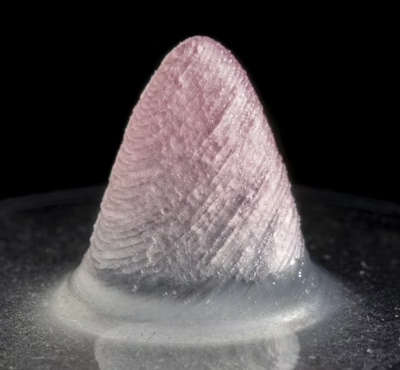
The tissue-engineered 3D ventricle model. Credit: Harvard SEAS
When she applied electrical stimulation to 3D-printed structures made with FIG ink, she found it triggered a coordinated wave of contractions in alignment with the direction of those fibers. In a ventricle-shaped structure, “it was very exciting to see the chamber actually pumping in a similar way to how real heart ventricles pump,” Choi says.
As she experimented with more printing directions and ink formulas, she found she could generate even stronger contractions within ventricle-like shapes.
“Compared to the real heart, our ventricle model is simplified and miniaturized,” she says. The team is now working toward building more life-like heart tissues with thicker muscle walls that can pump fluid more strongly. Despite not being as strong as real heart tissue, the 3D-printed ventricle could pump 5-20 times more fluid volume than previous 3D-printed heart chambers.
The team says the technique can also be used to build heart valves, dual-chambered miniature hearts, and more.
“FIGs are but one tool we have developed for additive manufacturing,” Parker says. “We have other methods in development as we continue our quest to build human tissues for regenerative therapeutics. The goal is not to be tool driven – we are tool agnostic in our search for a better way to build biology.”
Additional authors include Keel Yong Lee, Sean L. Kim, Huibin Chang, John F. Zimmerman, Qianru Jin, Michael M. Peters, Herdeline Ann M. Ardoña, Xujie Liu, Ann-Caroline Heiler, Rudy Gabardi, Collin Richardson, William T. Pu, and Andreas Bausch.
This work was sponsored by SEAS; the National Science Foundation through the Harvard University Materials Research Science and Engineering Center (DMR-1420570, DMR-2011754); the National Institutes of Health and National Center for Advancing Translational Sciences (UH3HL141798, 225 UG3TR003279); the Harvard University Center for Nanoscale Systems (CNS), a member of the National Nanotechnology Coordinated Infrastructure Network (NNCI) which is supported by the National Science Foundation (ECCS-2025158, S10OD023519); and the American Chemical Society’s Irving S. Sigal Postdoctoral Fellowships.
‘Brainless’ robot can navigate complex obstacles
Stack AV Launches Autonomous Trucking Business to Revolutionize the Transportation of Goods
Robotic driving seat helping to improve safety of highly automated vehicles
Bringing Robotics to Small Manufacturing
Interview with Jean Pierre Sleiman, author of the paper “Versatile multicontact planning and control for legged loco-manipulation”
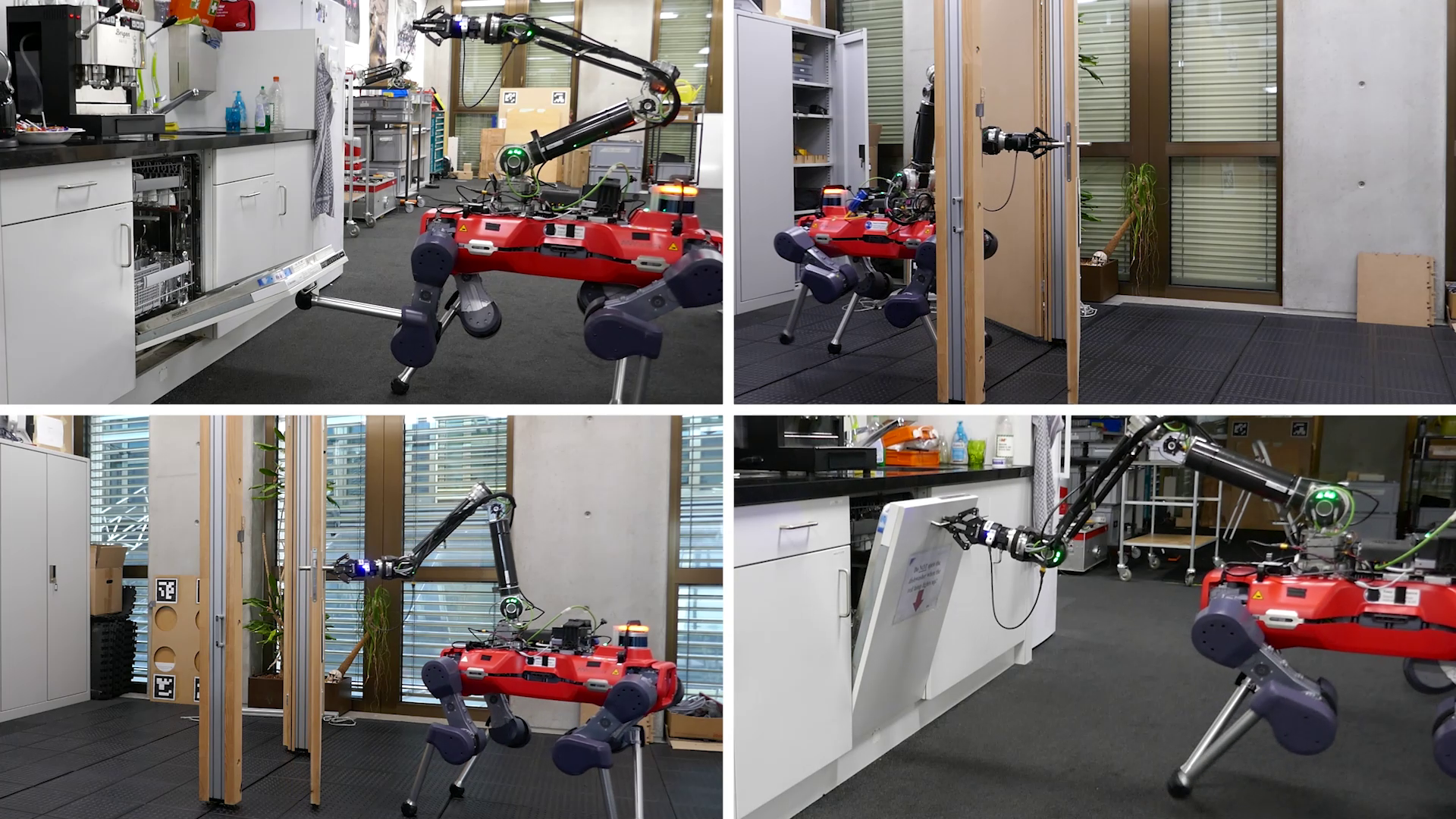
Picture from paper “Versatile multicontact planning and control for legged loco-manipulation“. © American Association for the Advancement of Science
We had the chance to interview Jean Pierre Sleiman, author of the paper “Versatile multicontact planning and control for legged loco-manipulation”, recently published in Science Robotics.
What is the topic of the research in your paper?
The research topic focuses on developing a model-based planning and control architecture that enables legged mobile manipulators to tackle diverse loco-manipulation problems (i.e., manipulation problems inherently involving a locomotion element). Our study specifically targeted tasks that would require multiple contact interactions to be solved, rather than pick-and-place applications. To ensure our approach is not limited to simulation environments, we applied it to solve real-world tasks with a legged system consisting of the quadrupedal platform ANYmal equipped with DynaArm, a custom-built 6-DoF robotic arm.
Could you tell us about the implications of your research and why it is an interesting area for study?
The research was driven by the desire to make such robots, namely legged mobile manipulators, capable of solving a variety of real-world tasks, such as traversing doors, opening/closing dishwashers, manipulating valves in an industrial setting, and so forth. A standard approach would have been to tackle each task individually and independently by dedicating a substantial amount of engineering effort to handcraft the desired behaviors:
This is typically achieved through the use of hard-coded state-machines in which the designer specifies a sequence of sub-goals (e.g., grasp the door handle, open the door to a desired angle, hold the door with one of the feet, move the arm to the other side of the door, pass through the door while closing it, etc.). Alternatively, a human expert may demonstrate how to solve the task by teleoperating the robot, recording its motion, and having the robot learn to mimic the recorded behavior.
However, this process is very slow, tedious, and prone to engineering design errors. To avoid this burden for every new task, the research opted for a more structured approach in the form of a single planner that can automatically discover the necessary behaviors for a wide range of loco-manipulation tasks, without requiring any detailed guidance for any of them.
Could you explain your methodology?
The key insight underlying our methodology was that all of the loco-manipulation tasks that we aimed to solve can be modeled as Task and Motion Planning (TAMP) problems. TAMP is a well-established framework that has been primarily used to solve sequential manipulation problems where the robot already possesses a set of primitive skills (e.g., pick object, place object, move to object, throw object, etc.), but still has to properly integrate them to solve more complex long-horizon tasks.
This perspective enabled us to devise a single bi-level optimization formulation that can encompass all our tasks, and exploit domain-specific knowledge, rather than task-specific knowledge. By combining this with the well-established strengths of different planning techniques (trajectory optimization, informed graph search, and sampling-based planning), we were able to achieve an effective search strategy that solves the optimization problem.
The main technical novelty in our work lies in the Offline Multi-Contact Planning Module, depicted in Module B of Figure 1 in the paper. Its overall setup can be summarized as follows: Starting from a user-defined set of robot end-effectors (e.g., front left foot, front right foot, gripper, etc.) and object affordances (these describe where the robot can interact with the object), a discrete state that captures the combination of all contact pairings is introduced. Given a start and goal state (e.g., the robot should end up behind the door), the multi-contact planner then solves a single-query problem by incrementally growing a tree via a bi-level search over feasible contact modes jointly with continuous robot-object trajectories. The resulting plan is enhanced with a single long-horizon trajectory optimization over the discovered contact sequence.
What were your main findings?
We found that our planning framework was able to rapidly discover complex multi- contact plans for diverse loco-manipulation tasks, despite having provided it with minimal guidance. For example, for the door-traversal scenario, we specify the door affordances (i.e., the handle, back surface, and front surface), and only provide a sparse objective by simply asking the robot to end up behind the door. Additionally, we found that the generated behaviors are physically consistent and can be reliably executed with a real legged mobile manipulator.
What further work are you planning in this area?
We see the presented framework as a stepping stone toward developing a fully autonomous loco-manipulation pipeline. However, we see some limitations that we aim to address in future work. These limitations are primarily connected to the task-execution phase, where tracking behaviors generated on the basis of pre-modeled environments is only viable under the assumption of a reasonably accurate description, which is not always straightforward to define.
Robustness to modeling mismatches can be greatly improved by complementing our planner with data-driven techniques, such as deep reinforcement learning (DRL). So one interesting direction for future work would be to guide the training of a robust DRL policy using reliable expert demonstrations that can be rapidly generated by our loco-manipulation planner to solve a set of challenging tasks with minimal reward-engineering.
About the author

|
Jean-Pierre Sleiman received the B.E. degree in mechanical engineering from the American University of Beirut (AUB), Lebanon, in 2016, and the M.S. degree in automation and control from Politecnico Di Milano, Italy, in 2018. He is currently a Ph.D. candidate at the Robotic Systems Lab (RSL), ETH Zurich, Switzerland. His current research interests include optimization-based planning and control for legged mobile manipulation. |
Japan city to use robots to tackle rising school truancy
Rockwell Automation signs agreement to acquire autonomous robotics leader Clearpath Robotics
Do robots have to be human-like for us to trust them?
Tackling loneliness with ChatGPT and robots
As the last days of summer set, one is wistful of the time spent with loved ones sitting on the beach, traveling on the road, or just sharing a refreshing ice cream cone. However, for many Americans such emotional connections are rare, leading to high suicide rates and physical illness. In a recent study by the Surgeon General, more than half of the adults in the USA experience loneliness, with only 39% reporting feeling “very connected to others.” As Dr. Vivek H. Murthy states: “Loneliness is far more than just a bad feeling—it harms both individual and societal health. It is associated with a greater risk of cardiovascular disease, dementia, stroke, depression, anxiety, and premature death. The mortality impact of being socially disconnected is similar to that caused by smoking up to 15 cigarettes a day and even greater than that associated with obesity and physical inactivity.” In dollar terms, this epidemic accounts for close to $7 billion of Medicare spending annually, on top of $154 billion of yearly worker absenteeism.
As a Venture Capitalist, I have seen a growing number of pitch decks for conversational artificial intelligence in place of organic companions (some of these have wellness applications, while others are more lewd). One of the best illustrations of how AI-enabled chatbots are entering human relationships is in a recent article by the New York Times reporter Erin Griffin, who spent five days testing the AI buddy Pi. Near the end of the missive, she exclaims, “It wasn’t until Monday morning, after hours of intermittent chatting throughout the weekend, that I had my ‘aha’ moment with Pi. I was feeling overwhelmed with work and unsure of how to structure my day, a recurring hangup that often prevents me from getting started. ‘Good morning,’ I typed into the app. ‘I don’t have enough time to do everything I need to do today!’ With a level of enthusiasm only a robot could muster before coffee, Pi pushed me to break down my to-do list to create a realistic plan. Like much of the bot’s advice, it was obvious and simple, the kind of thing you would read in a self-help article by a productivity guru. But it was tailored specifically to me — and it worked.” As the reporter reflected on her weekend with the bot, she commented further, “I could have dumped my stress on a family member or texted a friend. But they are busy with their own lives and, well, they have heard this before. Pi, on the other hand, has infinite time and patience, plus a bottomless well of encouraging affirmations and detailed advice.”
In a population health study cited by General Murthy, the demographic that is most isolated in America is people over the age of 65. This is also the group that is most affected by physical and cognitive decline due to loneliness. Doctors Qi and Wu presented to Neurology Live a survey of the benefits of AI in their June paper, “ChatGPT: A Promising Tool to Combat Social Isolation and Loneliness in Older Adults With Mild Cognitive Impairment.” According to the authors, “ChatGPT can provide emotional support by offering a nonjudgmental space for individuals to express their thoughts and feelings. This can help alleviate loneliness and provide a sense of connection, which is crucial for well-being.” The researchers further cited ancillary uses, “ChatGPT can also assist with daily tasks and routines. By offering reminders for appointments, medications, and other daily tasks, this AI model can help older adults with MCI (mild cognitive impairment) maintain a sense of independence and control over their lives.” The problem with ChatGPT for geriatric plus populations is the form factors, as most seniors are not the most tech-savvy. This is an opportunity for roboticists.
Last Tuesday, Intuition Robotics announced it scored an additional financing of $25 million for expanding its “AI care companions” to all senior households. While its core product, ElliQ, does not move, its engagement offers the first glimpse of the benefits of social robots at mass. In speaking about the future, I interviewed its founder/CEO, Dor Skuler, last week. He shared with me his vision, “At this time, we don’t have plans to add legs or wheels to ElliQ, but we are always looking to add new activities or conversational features that can benefit the users. Our goal is to continue getting ElliQ into as many homes as possible to spread its benefits to even more older adults. We plan to create more partnerships with governments and aging agencies and are developing more partnerships within the healthcare industry. With this new funding, we will capitalize on our strong pipeline and fund the growth of our go-to-market activities.”
Unlike the stuffed animal executions of Paro and Tombot, ElliQ looks like an attractive home furnishing (and winner of the 2003 International Design Award). According to Skuler, this was very intentional, “We placed very high importance on the design of ElliQ to make it as easy as possible to use. We also knew we older adults needed technology that celebrated them and the aging process rather than focusing on disabilities and what they may no longer be able to do by themselves.” At the same time, the product underwent a rigorous testing and development stage that put its customer at the center of the process. “We designed ElliQ with the goal of helping seniors who are aging in place at home combat loneliness and social isolation. This group of seniors who participated in the development and beta testing helped us to shape and improve ElliQ, ensuring it had the right personality, character, mannerisms, and other modalities of interaction (like movement, conversation design, LEDs, and on-screen visuals) to form meaningful bonds with real people.” He further observed in the testing with hundreds of seniors, “we’ve witnessed older adults forming an actual relationship with ElliQ, closer to how one would see a roommate rather than a smart appliance.”
The results since deploying in homes throughout New York have been astounding in keeping older populations more socially and mentally engaged. As ElliQ’s creator elaborated, “In May 2022, we announced a partnership with the New York State Office for the Aging to bring 800+ ElliQ units to seniors across New York State at no cost to the end users. Just a few weeks ago this year, we announced a renewal of that partnership and the amazing results we’ve seen so far including a 95% reduction in loneliness and great improvement in well-being among older adults using the platform. ElliQ users throughout New York have demonstrated exceptionally high levels of engagement consistently over time, interacting with their ElliQ over 30 times per day, 6 days a week. More than 75% of these interactions are related to improving older adults’ social, physical, and mental well-being.”
To pedestrian cynics, ElliQ might look like an Alexa knockoff leading them to question why couldn’t the FAANG companies cannibalize the startup. Skuler’s response, “Alexa and other digital assistant technology were designed with the masses in mind or for younger end users. They also focus mainly on reactive AI, meaning they do not provide suggestions or talk with users unless prompted. ElliQ is designed to engage users over time, using a proactive approach to engagement. Its proactive suggestions and conversational capabilities foster a deep relationship with the user. Moreover, ElliQ’s integration of Generative AI and Large Language Models (LLMs) enables rich and continuous conversational experiences, allowing for more contextual, personalized, and goal-driven interactions. These capabilities and unique features such as drinking coffee with ElliQ in cafes around the world or visiting a virtual art museum, bring ElliQ and the user close together, creating trust that allows ElliQ to motivate the older adult to lead a more healthy and engaged lifestyle.”
While ElliQ and OpenAI’s ChatGPT have shown promise in treating mental illness, some health professionals are still not convinced. At MIT, professor and psychologist, Sherry Turkle, worries that the interactions of machines “push us along a road where we’re encouraged to forget what makes people special.” Dr. Turkle demures, “The performance of empathy is not empathy. The area of companion, lover therapist, best friend is really one of the few areas where people need people.”


